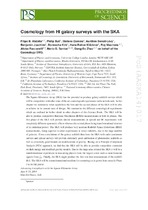| dc.contributor.author | Maartens, Roy | |
| dc.contributor.author | Abdalla, Filipe B. | |
| dc.contributor.author | Bull, Philip | |
| dc.contributor.author | Camera, Stefano | |
| dc.contributor.author | Benoit-Levy, Aurelien | |
| dc.contributor.author | Joachimi, Benjamin | |
| dc.contributor.author | Kirk, Donnacha | |
| dc.contributor.author | Klöckner, Hans-Rainer | |
| dc.contributor.author | Raccanelli, Alvise | |
| dc.contributor.author | Santos, Mario G. | |
| dc.contributor.author | Zhao, Gong-Bo | |
| dc.date.accessioned | 2015-10-20T19:05:04Z | |
| dc.date.available | 2015-10-20T19:05:04Z | |
| dc.date.issued | 2014 | |
| dc.identifier.citation | Abdalla, F.B., (2014). Cosmology from HI galaxy surveys with the SKA. Paper presented at Advancing Astrophysics with the Square Kilometre Array, Giardini Naxos, Italy. PoS(AASKA14)017KA. | en_US |
| dc.identifier.issn | 1824-8039 | |
| dc.identifier.uri | http://hdl.handle.net/10566/1817 | |
| dc.description.abstract | The Square Kilometer Array (SKA) has the potential to produce galaxy redshift surveys which
will be competitive with other state of the art cosmological experiments in the next decade. In this
chapter we summarise what capabilities the first and the second phases of the SKA will be able
to achieve in its current state of design. We summarise the different cosmological experiments
which are outlined in further detail in other chapters of this Science Book. The SKA will be
able to produce competitive Baryonic Oscillation (BAOs) measurements in both its phases. The
first phase of the SKA will provide similar measurements in optical and IR experiments with
completely different systematic effects whereas the second phase being transformational in terms
of its statistical power. The SKA will produce very accurate Redshift Space Distortions (RSD)
measurements, being superior to other experiments at lower redshifts, due to the large number
of galaxies. Cross correlations of the galaxy redshift data from the SKA with radio continuum
surveys and optical surveys will provide extremely good calibration of photometric redshifts as
well as extremely good bounds on modifications of gravity. Basing on a Principle Component
Analysis (PCA) approach, we find that the SKA will be able to provide competitive constraint
on dark energy and modified gravity models. Due to the large area covered the SKA it will be a
transformational experiment in measuring physics from the largest scales such as non-Gaussian
signals. Finally, the SKA might produce the first real time measurement of the redshift
drift. The SKA will be a transformational machine for cosmology as it grows from an early Phase
1 to its full power. | en_US |
| dc.language.iso | en | en_US |
| dc.publisher | Proceedings of Science | en_US |
| dc.rights | Based on the open access philosophy proceedings published on PoS can be read free of charge. No subscription nor registration is required of readers. This article can be accessed at http://pos.sissa.it/archive/conferences/215/017/AASKA14_017.pdf | |
| dc.subject | Square Kilometre Array (SKA) | en_US |
| dc.subject | Galaxies | en_US |
| dc.subject | Cosmological experiments | en_US |
| dc.subject | Baryonic Oscillation (BAOs) | en_US |
| dc.subject | Redshift Space Distortions (RSD) | en_US |
| dc.subject | Principle Component Analysis (PCA) | en_US |
| dc.title | Cosmology from HI galaxy surveys with the SKA | en_US |
| dc.type | Conference Paper | en_US |
| dc.privacy.showsubmitter | false | |
| dc.status.ispeerreviewed | true | |

